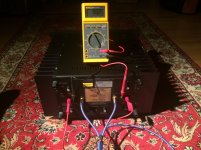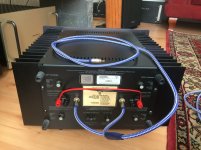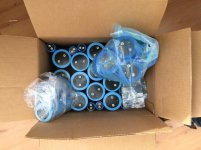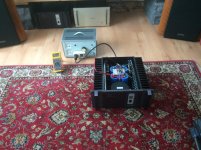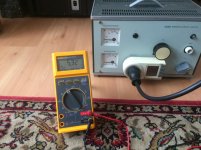Inverted to Non inverted rca
In the same line I think:
I have a preamplifier with two sets of RCA outputs one normal or non inverted and one inverted.
What I want is to convert the inverted to non-inverted.
Is it as easy to switch the plus and minus leads of the non-inverted RCA's to get them being non-converted?
In the same line I think:
I have a preamplifier with two sets of RCA outputs one normal or non inverted and one inverted.
What I want is to convert the inverted to non-inverted.
Is it as easy to switch the plus and minus leads of the non-inverted RCA's to get them being non-converted?
Hi Zen Mod and It's all in my Head,
Just got two Y RCA cables and I wonder if this is the way how to configure the Threshold S/500 into a mono-block:
https://www.diyaudio.com/forums/attachment.php?attachmentid=983843&stc=1&d=1631827510
I'm contemplating to drive the Infinity Kappa 9A's in extended mode with two mono-paralleled S/500's on the woofers and CJ Premier One b on the mid/high sections.
Maybe one Threshold S/500 is enough on the Kappa woofers but I'm not sure and a pair of SA/1's is gotten just too expensive these last years.
Just got two Y RCA cables and I wonder if this is the way how to configure the Threshold S/500 into a mono-block:
https://www.diyaudio.com/forums/attachment.php?attachmentid=983843&stc=1&d=1631827510
I'm contemplating to drive the Infinity Kappa 9A's in extended mode with two mono-paralleled S/500's on the woofers and CJ Premier One b on the mid/high sections.
Maybe one Threshold S/500 is enough on the Kappa woofers but I'm not sure and a pair of SA/1's is gotten just too expensive these last years.
Attachments
I see RCA Y cable clearly, and that's it
if red cable connecting two red binding posts is one wire/dead short, that's it
now just connect speaker to any side, red binding post is positive, black binding post is negative
if red cable connecting two red binding posts is one wire/dead short, that's it
now just connect speaker to any side, red binding post is positive, black binding post is negative
Done!
Was a bit afraid to turn the first S/500 on, but I have two mono blocks now thanks to you guys!
https://www.diyaudio.com/forums/attachment.php?attachmentid=983991&stc=1&d=1631881945
https://www.diyaudio.com/forums/attachment.php?attachmentid=983992&stc=1&d=1631881945
So it's still the same 250 Watts at 8 Ohms but now with more current into lower loads (Kappa 9A dual woofers in extended mode) and lower output impedance.
Maybe there are also negative points (twice the cost ;-)).
Thanks again for your great help converting my S/500's in a kind of SA/1's without the meters and 160 Watts Class A.
Was a bit afraid to turn the first S/500 on, but I have two mono blocks now thanks to you guys!
https://www.diyaudio.com/forums/attachment.php?attachmentid=983991&stc=1&d=1631881945
https://www.diyaudio.com/forums/attachment.php?attachmentid=983992&stc=1&d=1631881945
So it's still the same 250 Watts at 8 Ohms but now with more current into lower loads (Kappa 9A dual woofers in extended mode) and lower output impedance.
Maybe there are also negative points (twice the cost ;-)).
Thanks again for your great help converting my S/500's in a kind of SA/1's without the meters and 160 Watts Class A.
Attachments
Reforming new powesupply capacitors
Should I decide to put in 4 new (one set is two years old on a shelf) powersupply caps per amplifier, could I reform those power caps to place them in the circuit of the Threshold and very slowly with the use of a Variac with a Volt- and Ampmeter inside reform the by turning the AC voltage up let say 5 Volt per 5 minutes? Thresholds have no softstart circuit and/or relays in their powersupply.
Should I decide to put in 4 new (one set is two years old on a shelf) powersupply caps per amplifier, could I reform those power caps to place them in the circuit of the Threshold and very slowly with the use of a Variac with a Volt- and Ampmeter inside reform the by turning the AC voltage up let say 5 Volt per 5 minutes? Thresholds have no softstart circuit and/or relays in their powersupply.
best to bring them to life prior to installing them in amp
when I have ( and I have ) caps laying in box for long time, I just connect them with 100K resistor in series to DC voltage source , voltage close or equal to their rating, and leave them for few days that way
after checking of voltage , I just short them with same resistor and leave for few days that way
when I have ( and I have ) caps laying in box for long time, I just connect them with 100K resistor in series to DC voltage source , voltage close or equal to their rating, and leave them for few days that way
after checking of voltage , I just short them with same resistor and leave for few days that way
Reforming nos caps
The only DC Voltage source I have are the power supplies of my amplifiers it self.
And they are not filtered yet after the diode bridges of course.
I bought four caps new from Mouser and I have four of the same caps on a shelf which I bought two years ago.
I have a Fluke Multimeter a PEAK ESR70 ESR meter a capacitance meter, a 20A Variac and a Tektronix scope and a box of big caps with the newest ones in a plastic bag on top:
https://www.diyaudio.com/forums/attachment.php?attachmentid=984484&stc=1&d=1632050234
Does the type of resistor (carbon, wirewound metalfilm) or wattage any difference?
The only DC Voltage source I have are the power supplies of my amplifiers it self.
And they are not filtered yet after the diode bridges of course.
I bought four caps new from Mouser and I have four of the same caps on a shelf which I bought two years ago.
I have a Fluke Multimeter a PEAK ESR70 ESR meter a capacitance meter, a 20A Variac and a Tektronix scope and a box of big caps with the newest ones in a plastic bag on top:
https://www.diyaudio.com/forums/attachment.php?attachmentid=984484&stc=1&d=1632050234
Does the type of resistor (carbon, wirewound metalfilm) or wattage any difference?
Attachments
Last edited:
current through 100K resistor is so small that wattage is irrelevant
for DC source, well, improvise ......
for DC source, well, improvise ......
Reforming NOS caps
Hi Zenmod,
Have chosen for this procedure because my ESR dedicated meter gave for all caps a zero reading.
Checking Caps
This chapter:
Forming & Reforming Aluminum Electrolytic Capacitors
When capacitors are made the manufacturer places a voltage across the terminals to form the oxide film on the plates, always a higher voltage than the cap is rated for. The oxide film is semi-permanent, but if the cap sits unused for a long period of time, the oxide film can degrade. This makes the capacitor vulnerable to shorting out the first time power is applied. Thus the advice to slowly power up old equipment using a Variac. This builds up the oxide film until it can support the full operating voltage. When a new or long-unused cap is installed in a circuit and first powered up, it will have a significant leakage current. This current falls off for quite a long period until it reaches near zero. The process can actually take days to weeks before the minimum current is observed.
Remember that significant leakage current equals heat being generated inside the capacitor. When powering up old equipment, don't assume that all is well just because the caps support the working voltage briefly. Failure can occur as the cap heats up because the leakage current is still too high. When bringing old equipment back to life, raise the voltage slowly and in several stages. Power down frequently and allow the caps to rest and cool off internally. Then, after half an hour or more, power up again to a slightly higher voltage. After the caps have accumulated some total power on time, they'll have a better chance of survival. That said, if they still fail standard tests, replacement is the only remedy.
After many years of operation, caps will have "adjusted" their internal oxide layers for the applied voltage. If the voltage is increased for some reason, say a high line condition, the DC leakage current can increase tremendously, possibly initiating a failure. Entirely speculation on my part, but this may explain why capacitor replacement in older tube equipment is so universally recommended; new caps can handle surge voltages much better than old ones, unless they've been reformed to their full ratings.
https://www.diyaudio.com/forums/attachment.php?attachmentid=984815&stc=1&d=1632153587
https://www.diyaudio.com/forums/attachment.php?attachmentid=984816&stc=1&d=1632153587
https://www.diyaudio.com/forums/attachment.php?attachmentid=984817&stc=1&d=1632153587
Hi Zenmod,
Have chosen for this procedure because my ESR dedicated meter gave for all caps a zero reading.
Checking Caps
This chapter:
Forming & Reforming Aluminum Electrolytic Capacitors
When capacitors are made the manufacturer places a voltage across the terminals to form the oxide film on the plates, always a higher voltage than the cap is rated for. The oxide film is semi-permanent, but if the cap sits unused for a long period of time, the oxide film can degrade. This makes the capacitor vulnerable to shorting out the first time power is applied. Thus the advice to slowly power up old equipment using a Variac. This builds up the oxide film until it can support the full operating voltage. When a new or long-unused cap is installed in a circuit and first powered up, it will have a significant leakage current. This current falls off for quite a long period until it reaches near zero. The process can actually take days to weeks before the minimum current is observed.
Remember that significant leakage current equals heat being generated inside the capacitor. When powering up old equipment, don't assume that all is well just because the caps support the working voltage briefly. Failure can occur as the cap heats up because the leakage current is still too high. When bringing old equipment back to life, raise the voltage slowly and in several stages. Power down frequently and allow the caps to rest and cool off internally. Then, after half an hour or more, power up again to a slightly higher voltage. After the caps have accumulated some total power on time, they'll have a better chance of survival. That said, if they still fail standard tests, replacement is the only remedy.
After many years of operation, caps will have "adjusted" their internal oxide layers for the applied voltage. If the voltage is increased for some reason, say a high line condition, the DC leakage current can increase tremendously, possibly initiating a failure. Entirely speculation on my part, but this may explain why capacitor replacement in older tube equipment is so universally recommended; new caps can handle surge voltages much better than old ones, unless they've been reformed to their full ratings.
https://www.diyaudio.com/forums/attachment.php?attachmentid=984815&stc=1&d=1632153587
https://www.diyaudio.com/forums/attachment.php?attachmentid=984816&stc=1&d=1632153587
https://www.diyaudio.com/forums/attachment.php?attachmentid=984817&stc=1&d=1632153587
Attachments
you can't measure cap while in circuit
they are connected to channel pcbs, also having bridges at other side
they are connected to channel pcbs, also having bridges at other side
- Home
- Amplifiers
- Pass Labs
- Bridging two Threshold S/500 optical bias
